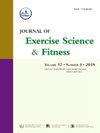Evaluation of rest interval following a series of tuck jumps on anaerobic performance
IF 2.4
2区 医学
Q2 SPORT SCIENCES
引用次数: 0
Abstract
Background/objective
This study assessed the influence of rest interval duration after tuck jumps on 10-s Wingate outcomes and countermovement jump height.
Methods
Eighteen resistance trained individuals (males: n = 10, 21.3 ± 3.6 years; females: n = 8, 22.1 ± 2.2 years) volunteered to participate in four sessions: familiarization, 3-min rest interval with no jumps (CON), and two randomized experimental sessions with a rest interval of either 1-min (ER1) or 5-min (ER5) after a series of tuck jumps. Countermovement jump (CMJ) height was assessed at baseline (PRE) and after (POST) the CON, ER1, and ER5 conditions, and 10-s Wingate cycling testing. Wingate relative peak power (RPP) and mean peak power (RMP) were measured. Separate mixed-factorial repeated measures analyses of variance assessed changes across conditions and sex for the Wingate variables and conditions, sex, and time for CMJ height at an alpha of p ≤ 0.05.
Results
RPP and RMP were significantly greater than CON for ER1 by 0.92 ± 0.23 W kg−1 and 0.41 ± 0.14 W kg−1, respectively, and ER5 by 0.77 ± 0.23 W kg−1 and 0.36 ± 0.10 W kg−1, respectively. ER1 and ER5 RPP and RMP were similar (p > 0.05). For CMJ height, there was only a main effect for sex as males jumped higher than females by 31.3 % (p = 0.002).
Conclusion
Performing tuck jumps prior to anaerobic exercise may increase performance for up to 5-min
评价一系列塔克跳后休息间隔对无氧性能的影响
背景/目的评价塔克跳后休息间隔时间对10-s Wingate结果和反动作跳高的影响。方法阻力训练个体18例(男性10例,年龄21.3±3.6岁;女性:n = 8, 22.1±2.2岁)自愿参加四个阶段:熟悉、3分钟无跳跃休息间隔(CON)和两个随机实验阶段,在一系列塔克跳跃后休息间隔为1分钟(ER1)或5分钟(ER5)。在CON、ER1和ER5条件的基线(PRE)和后(POST)以及10-s Wingate循环测试中评估反向运动跳跃(CMJ)高度。测量温盖特相对峰值功率(RPP)和平均峰值功率(RMP)。单独的混合因子重复测量方差分析评估了不同条件和性别的Wingate变量的变化,以及条件、性别和时间对CMJ高度的影响,alpha值为p≤0.05。结果ER1组rpp和RMP分别显著高于CON组0.92±0.23 W kg - 1和0.41±0.14 W kg - 1, ER5组rpp和RMP分别显著高于CON组0.77±0.23 W kg - 1和0.36±0.10 W kg - 1。RPP与RMP相似(p >;0.05)。对于CMJ高度,只有性别的主要影响,男性比女性高31.3% (p = 0.002)。结论:在无氧运动前进行塔克跳可以提高运动表现达5分钟
本文章由计算机程序翻译,如有差异,请以英文原文为准。
求助全文
约1分钟内获得全文
求助全文
来源期刊
CiteScore
5.10
自引率
3.60%
发文量
54
审稿时长
31 days
期刊介绍:
The Journal of Exercise Science and Fitness is the official peer-reviewed journal of The Society of Chinese Scholars on Exercise Physiology and Fitness (SCSEPF), the Physical Fitness Association of Hong Kong, China (HKPFA), and the Hong Kong Association of Sports Medicine and Sports Science (HKASMSS). It is published twice a year, in June and December, by Elsevier.
The Journal accepts original investigations, comprehensive reviews, case studies and short communications on current topics in exercise science, physical fitness and physical education.

 求助内容:
求助内容: 应助结果提醒方式:
应助结果提醒方式:


